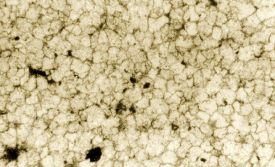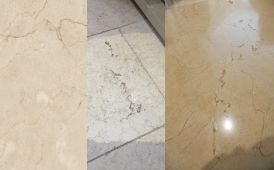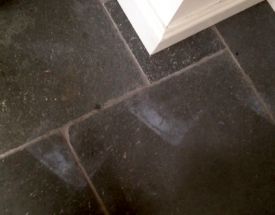The simplicity of water-based steam cleaning can be appealing, but repeated use of too much super heated water can lead to risks of residual staining, mobilisation of salts and corrosion of hidden particles of Iron within some limestone surfaces.

Surface of a Limestone magnified by 120 microns
Steam can penetrate the small cracks and fissures on the surface of the limestone.
This does clean the limestone, but will also embed water into the surface.
Repeated cleaning using a steam cleaner can activate salts and weaken the stone over time. This can also lead to spalling or fragmentation of the surface.

COMPROMISED SEALER?
Surfaces that have been treated with an impregnating sealers can also be compromised. Steam cleaning does not normally remove the impregnating sealer, however repeated use can expose new fissures and capillaries within the stone. The newly exposed and unsealed surface takes in more dirt and becomes harder to clean, which then requires more frequent cleaning. This increase in cleaning can exacerbate the problem.
SURFACE SEALER DAMAGE?

Sealers used to finish the surface of stone can also be damaged. Steam is often used to remove paints, wall papers and other
coatings from surfaces. If a film forming
sealer has been used then contact by a
steam cleaner can cause a partial separation of the seal from the surface of the stone causing it to turn white or opaque.
 RUST STAINS ON THE SURFACE? Rust stains: These stains are reddish-orange and are caused by the oxidation (rusting) of iron. The source of iron staining is normally from within the stone, as most of the iron on the surface is normally
RUST STAINS ON THE SURFACE? Rust stains: These stains are reddish-orange and are caused by the oxidation (rusting) of iron. The source of iron staining is normally from within the stone, as most of the iron on the surface is normally
removed or discarded at the point of fabrication by the quarry. Therefore most Iron remains hidden and within the stone rather than on it; however, water from steam cleaning penetrating through natural fissures in the stone can activate or accelerate rusting.
CRUMBLING OF THE SURFACE?
Moisture from repeated steam cleaning can in some cases cause spalling or fragmentation of the surface.
cases cause spalling or fragmentation of the surface.
The migration of salts from moisture in the limestone can promote crumbling of the surface causing larger fissures and craters to appear. This is more
common in Limestone’s and marbles that contain naturally occurring mud or calcite veins which are more vulnerable to this issue.
WHAT TO DO?
COMPROMISED SEALER: Intensively clean the surface of the stone with LTP Grimex.Leave overnight to dry. Re-apply impregnating sealer – LTP Mattstone or LTP Colour Intensifier. For routine aftercare use LTP Waxwash. This is a PH neutral cleaner that will not damage the stone or compromise the seal.
SURFACE SEALER DAMAGE: Remove the Film forming sealer using LTP Grimex orLTP Solvex. Leave overnight to dry. Re-apply the film forming sealer – LTP Ironwax Satinor LTP Ironwax Gloss. For routine aftercare use LTP Floorshine. This gentle cleaner will clean the surface and repair the seal where it has worn from abraision every time the floor is washed.
RUST STAINS ON THE SURFACE: Intensively clean the surface of the stone with LTP Power Stripper. Leave overnight to dry.Re-apply impregnating sealer – LTP Mattstone orLTP Colour Intensifier. For routine aftercare use LTP Waxwash. This is a PH neutral cleaner that will not damage the stone or compromise the seal.
CRUMBLING OF THE SURFACE: Intensively clean the surface of the stone with LTP Grimex. Leave overnight to dry. Use a suitable resin stone filler of the correct colour to fill in the voids. Re- hone the surface of the stone using a twister pad and sponge down with a little water to remove any dust or sediment. Leave to dry. Re-apply impregnating sealer – LTP Mattstone or LTP Colour Intensifier. For routine aftercare use LTP Waxwash. This is a PH neutral cleaner that will not damage the stone or compromise the seal.
Still unsure? Try our new product guide to help select the correct products.
This information is offered without guarantee. The material should be used so as to take account of the local conditions and the surfaces to be treated. In case of doubt, the product should be tried out in an inconspicuous area.



